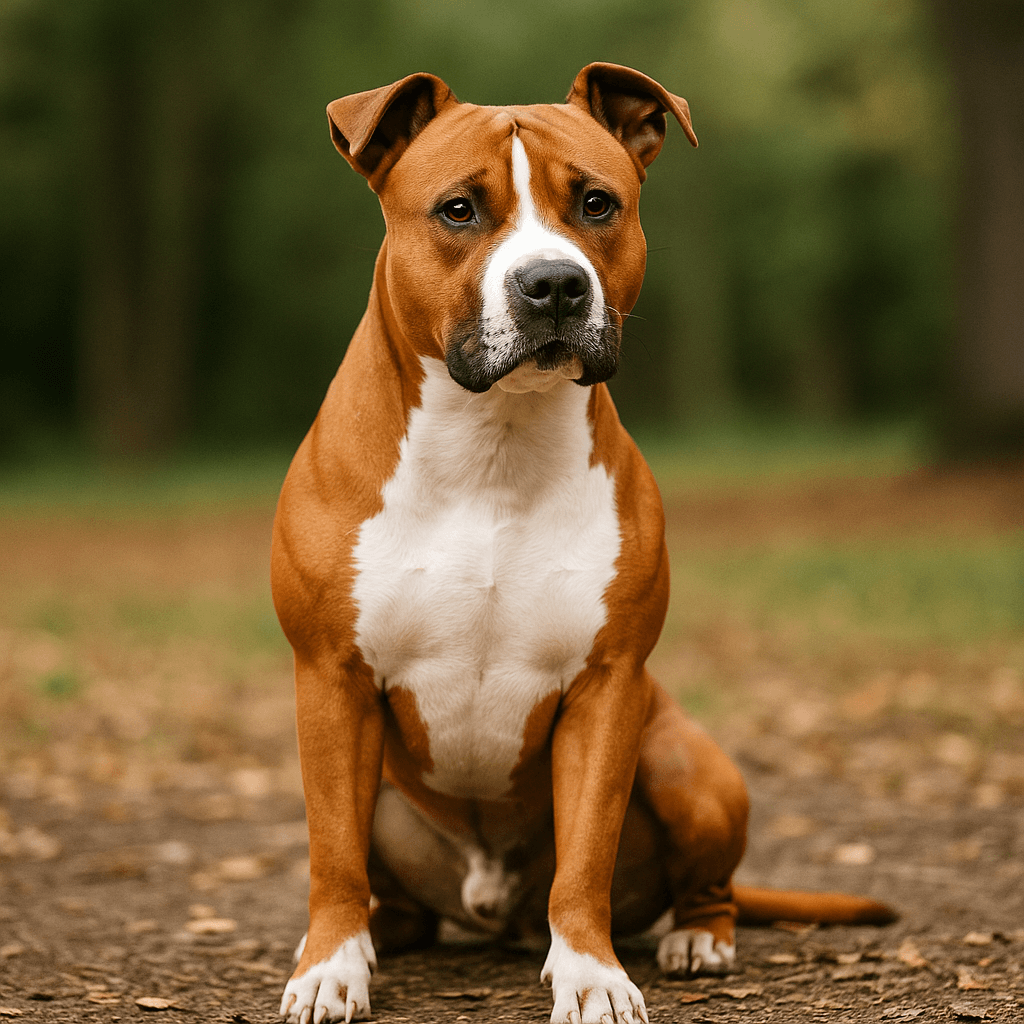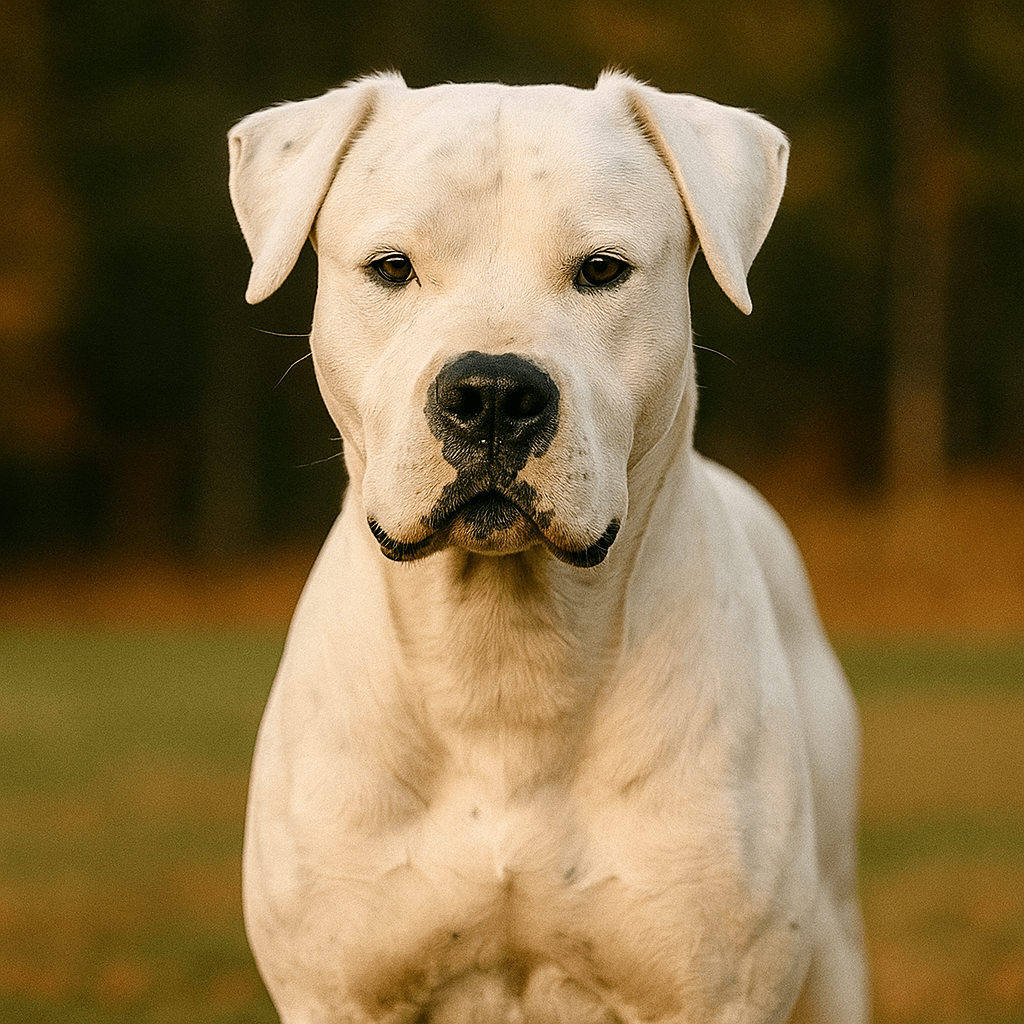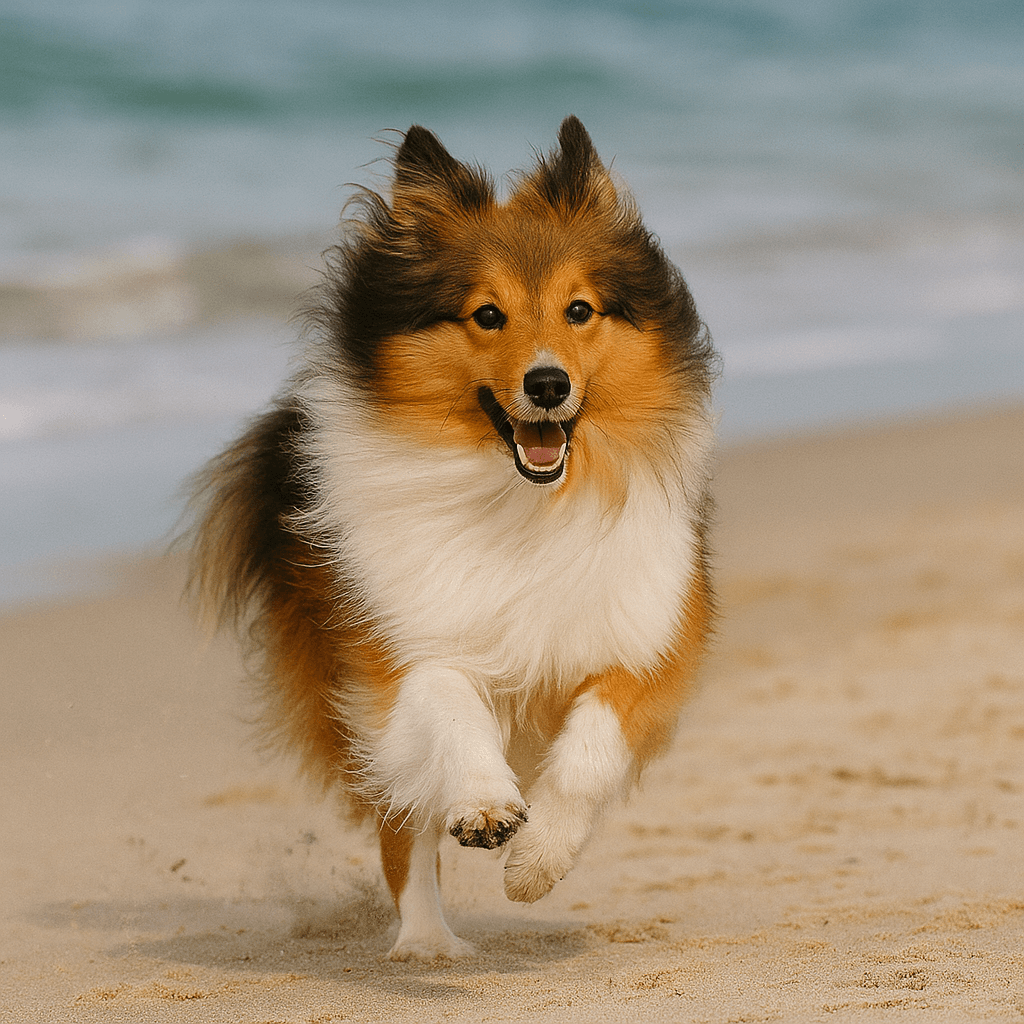
American Staffordshire Terrier (Amstaff) – Loyal, Strong, Devoted. The Complete Owner's Guide
The American Staffordshire Terrier – also known as the Amstaff – is a breed that evokes polarizing opinions. Some see it as a dangerous dog, others as a devoted family member. The truth, as is often the case, lies somewhere in between – and it all depends on how we approach raising and caring for this unique four-legged companion. In this article, we dispel myths, present facts, and share useful knowledge for anyone considering adopting an Amstaff.
🧬 The History of the Amstaff Breed – From Fighting Arenas to Family Couches
The history of the American Staffordshire Terrier dates back to the 19th century, when crossbreeding of bulldogs with various types of terriers, including the White English Terrier and Manchester Terrier, began in Great Britain. The goal was to create a dog that was exceptionally strong and durable, yet also agile and courageous. This is how the so-called "Bull and Terrier" was born – the ancestors of today's Amstaffs, which were originally used for rough-and-tumble sports such as bull-baiting and dog fighting.
With growing criticism of these cruel practices and their subsequent ban in the UK, the dogs began to be bred differently, with greater emphasis on their sociability. Emigrants took the breed to North America, where a new phase of selective breeding began.
In the United States, the breed gained popularity and evolved in both appearance and temperament. Breeders aimed to produce a dog that was not only strong and courageous, but above all, mentally stable, even-tempered, and loyal to its family. The new breed was named the "American Staffordshire Terrier" and was officially recognized by the American Kennel Club (AKC) in 1936. This was also intended to clearly distinguish the Amstaff from the closely related American Pit Bull Terrier, which was still associated with dog fighting.
In the following decades, Amstaffs gained a reputation as family dogs, guard dogs, and sporting dogs. They competed in obedience and agility competitions, and even served as therapy dogs. Despite the controversy surrounding their past, they are now considered one of the most versatile and intelligent working breeds.
📏 Appearance – muscular elegance

The Amstaff is a medium-sized dog with an exceptionally well-balanced, muscular build. Its body exudes strength and proportion. It exemplifies the perfect balance between mass and agility – it's no coincidence that its physique inspires both respect and admiration.
Compact, energetic, and perfectly muscled, his every movement exudes strength and confidence. His distinctive short, glossy coat lies close to his body, accentuating his muscular lines and overall dynamism. This is a dog that looks as if it was born for activity—whether it's sport, walking, or guarding.
The Amstaff's head is its hallmark: broad, with prominent cheekbones and a strong jaw. Its eyes, usually dark and round, give it an intelligent and alert expression, while its slightly rounded ears (often naturally drooping or semi-pricked) add to its charm.
Dogs of this breed are characterized by a variety of coat colors – almost all color variations are acceptable. The most common are:
- solid: black, blue, red (mahogany)
- brindle: with stripes on a lighter coat
- with white markings: often on the chest, muzzle or paws
Characteristic features:
- Height: 43–48 cm (males), 40–46 cm (females)
- Weight: 25-30 kg, although the weight/height ratio is more important than the numbers
- Body shape: compact, strong, with a broad chest and springy legs
- Head: short, broad with strongly developed cheek muscles
- Eyes: dark, deep-set, with a sharp and alert gaze
- Ears: natural or cropped in some countries (cropped ears are prohibited in Poland)
- Coat: short, hard to the touch, very easy to care for
Amstaffs often give the impression of being menacing dogs, but their appearance is actually a combination of strength and elegance. Their appearance is only a prelude to a rich interior – full of devotion, joy, and passion for life.
🧠 Character and temperament – the power that loves
The Amstaff is a dog with a huge heart and a loyalty that can surprise even experienced owners. Although wrongly considered aggressive, it is actually a dog with a stable temperament, loving people, and craving contact. However, the key is the right approach – the Amstaff is a breed that requires human closeness, predictability, and consistent training.
This intelligent, confident, and energetic dog loves to be the center of attention—it thrives in families where each member takes an active role in its life. This breed doesn't handle loneliness well—if left alone for long hours, it may show signs of frustration, such as destroying objects or barking excessively.
Amstaffs often develop strong bonds with children – they are patient, caring, and incredibly devoted. That's why they're sometimes called "nannies in a bodybuilder's body." However, as with any breed, playing with a dog should be supervised by an adult.
In contact with other animals, especially dogs of the same sex, they may exhibit dominant behaviors – which is why early and ongoing socialization is so important. Remember that the hunting instinct can be strong – cats or small animals may be treated as prey if the dog hasn't previously gotten to know and accept them.
The most important temperament features:
- Attachment to family: very strong, emotional
- Tolerance for children: exceptionally high with proper socialization
- Attitude towards strangers: cautious, but not aggressive – depending on upbringing
- Territoriality: average – they perform well as home guardians
- Hunting instinct: strong, requires control and supervision
The Amstaff is a dog that not only loves unconditionally but also demands responsible love and wise guidance. In the right hands, it becomes a loyal friend, a vigilant protector, and a full-fledged family member.
🐾 Training and socialization – the foundations of relationships

Training an Amstaff is not only a responsibility but also an investment in a stable, safe relationship with the dog. This breed is intelligent and quick to learn, but also requires a handler who is calm, consistent, and committed. Amstaffs hate monotony – learning must be fun and challenging, not routine.
The training process should begin as early as possible. A puppy should be exploring the world around them at just a few weeks old: other people, sounds, dogs, and environmental stimuli. Providing positive experiences is crucial – negative associations at a young age can impact adult behavior.
Reinforcing positive behaviors is particularly important in training an Amstaff. Physical punishment or shouting can only exacerbate fear or aggression. Instead, consistency, rewards, praise, and clearly defined rules yield excellent results. This dog enjoys working with its owner, as long as the owner clearly communicates their expectations.
In the case of Amstaffs, it's worth considering working with an experienced behavioral trainer, especially during the first few months of the dog's life. Obedience classes, socialization classes, and individual consultations can help the owner build authority in a healthy way.
Key principles of education:
- Socialization from the first weeks – contact with other dogs, people, children, different environments.
- Daily, short training sessions – preferably several times a day for 5–10 minutes.
- A fixed set of commands: "sit", "lie down", "stay", "leave it", "come to me", "no".
- Play as a form of learning – tug-of-war, hiding treats, logical games.
- Uninterrupted communication – the dog must know what is expected of him in every situation.
Amstaffs excel in canine sports such as obedience, agility, nosework, mantrailing, canicross, and frisbee. They are dogs born for work—both physical and intellectual—and it's worth meeting these needs.
Remember: neglecting training such a strong and independent dog can result in serious behavioral problems. However, a well-trained Amstaff is a model dog – obedient, focused, and strongly bonded to its owner.
🥩 Nutrition – Strength begins in the bowl
The Amstaff is an active dog with a large muscle mass – its diet must be tailored to its energy needs and provide the appropriate amount of protein.
What should be included in the diet?
- Protein (30–40%) : meat, fish, eggs
- Fats (15–20%) : fish oils, poultry
- Carbohydrates (10–20%) : rice, sweet potatoes, vegetables
- Supplements: glucosamine, vitamin E, omega-3 fatty acids
Avoid low-quality foods high in grains and artificial additives. It's also a good idea to consult with an animal nutritionist or veterinarian.
🛁 Care – short coat, easy care
The Amstaff is a low-maintenance breed, making it a good option for busy owners.
Care treatments:
- Coat: brush once a week
- Baths: every 2–3 months or when dirty
- Ears and eyes: regular inspection and cleaning
- Nails: trim every 2–4 weeks
- Teeth: Daily cleaning or dental chews
🏃 Physical activity – the need for movement is a necessity
The Amstaff requires daily activity, both physical and mental. This dog is born to be active – its muscular body and strong working instinct mean that without adequate exercise, it can become frustrated, bored, and consequently destructive. However, activity for the Amstaff doesn't just mean running around – it also means shared tasks that build bonds and a sense of accomplishment.
What does the ideal activity for an Amstaff look like?
Amstaffs love to be engaged. Long walks, challenging games, obedience training, and interaction with other dogs are the foundations of their daily routine. They need not only exercise but also intellectual stimulation, so it's important to provide a variety of activities.
Examples of activities:
- Walking and running (minimum 1.5–2 hours per day): ideally divided into two intense sessions.
- Playing with a ball, frisbee and fetching: physical activity and a form of reward in one.
- Running alongside a bike: a great option for energetic dogs, provided they are well-led.
- Tug of War: A controlled game that teaches rules and builds muscle and rapport.
- Nosework: develops natural tracking abilities while providing calm and focus.
🏥 Health – what to watch out for?
Amstaffs are quite hardy dogs, but like any breed, they have their weak points.
The most common health problems:
- Hip dysplasia
- Cerebellar ataxia – a genetic disease, tested in responsible breeders
- Skin allergies
- Food hypersensitivity
- Heart disease (e.g. cardiomyopathy)
Regular vet checkups, parasite prevention, and a good diet significantly extend a dog's lifespan. The average lifespan of an Amstaff is 12–16 years.
🏡 Amstaff in Poland – what is worth knowing?
In Poland, Amstaffs are very popular, both among enthusiasts of powerhouse breeds and among families who appreciate their friendly temperament. However, despite growing public awareness, this breed is still often controversial and requires special responsibility on the part of its owner.
The Amstaff is not included on the list of breeds considered aggressive in Poland, so there are no specific legal restrictions at the national level. However, some cities or municipalities may introduce internal regulations, such as requiring dogs to be on a leash and muzzled in public places. It's always worth checking local regulations.
This breed can also be subject to stigma – many people, unaware of its true nature, associate the Amstaff with aggression, which can lead to difficulties in renting apartments, using dog parks, or even meeting neighbors. Therefore, it's crucial that Amstaff owners cultivate good manners, socialize their dogs, and maintain a positive public image.
What is worth knowing as a future Amstaff owner in Poland?
- Breeding: It is best to choose only breeders associated with ZKwP (Kynological Association in Poland) - this guarantees appropriate genetic and health selection.
- Adoption: More and more foundations and shelters are adopting Amstaffs and Bull mixes. However, it's important to remember that these dogs often require an experienced owner, regular training, and personalized attention.
- Insurance: It is worth considering additional liability insurance in case of damage caused by your dog – especially if the breed is perceived as potentially dangerous.
- Guardian Responsibilities: A microchip, up-to-date vaccinations, a leash and a muzzle in public places are the basics of a responsible Amstaff guardian.
Pros of living with an Amstaff in Poland:
- A strong community of owners of this breed – forums, support groups and cynological events.
- There are more and more schools and trainers with experience in working with bull breeds.
- Openness to the adoption of Amstaffs by shelters – especially in large cities.
Owning an Amstaff in Poland is both a responsibility and a privilege. With the right approach, you can not only enjoy a wonderful relationship with your dog but also change the public perception of this unique breed.
❓Is an Amstaff the dog for you?
Amstaff is a dog for:
- active, consistent people with experience or willingness to learn,
- families with children (after appropriate upbringing),
- owners who will provide the dog with human contact, exercise and mental stimulation.
This is NOT a dog for:
- people looking for a sofa dog without the need for walks,
- people who avoid working on training,
- those who are afraid of the reactions of their surroundings and do not want to educate others.
📌 Frequently Asked Questions (FAQ) about Amstaffs
Are Amstaffs dangerous?
No. A properly raised and socialized Amstaff is an emotionally stable, loyal, and friendly dog. Aggression is not a characteristic of this breed, but rather the result of neglected parenting or traumatic experiences.
Is the Amstaff suitable for a family with children?
Yes, Amstaffs get along well with children, provided they've been properly socialized. They're often gentle, caring, and patient. As always, children and dogs should be supervised when playing together.
How much exercise does an Amstaff need?
At least 1.5 to 2 hours of physical and mental activity per day. This is a very energetic dog that needs intense walks, games, and challenges.
Does the Amstaff shed hair?
Yes, but in moderation. The short coat of an Amstaff does not require any special care, and brushing once a week is enough to keep it in good condition.
Can I adopt an Amstaff from a shelter?
Yes. Many foundations and shelters in Poland accept Amstaffs. However, it's worth knowing that some of these dogs have had difficult experiences, requiring greater commitment and knowledge from their future owners.
Can an Amstaff live in an apartment building?
Yes – provided their physical and mental needs are met. Amstaffs thrive in apartments, as long as they aren't left alone for long hours.
🔗 See also
🔗 Sources:
- American Kennel Club (AKC) – Breed Standard
- The Spruce Pets – Amstaff Guide
- IHeartDogs – Health Risks
- WebMD Pets – Breed Overview
- Tailwise – Feeding Chart
- TryFi Blog – Training Tips
- EachPaw – Temperament
- DogTime – Breed Characteristics
- VetStreet – Amstaff Breed Profile
🔗 Read also:
- 🏙️ Best dogs for apartments – breed ranking
- 💬 How Do Dogs Show Affection? Signals You Should Know
- 🐕 Is your dog pulling on the leash? Find out how to fix it.
- 🚗 How to safely transport a dog in a car?
- 🐾 How to teach your dog to stay home alone
- 🛏️ Can a dog sleep in bed with its owner? Facts, myths, and behavioral advice.
See more at: Petto.com.pl






















 https://petto.com.pl
https://petto.com.pl